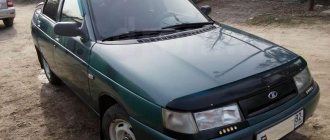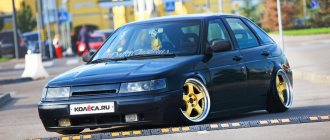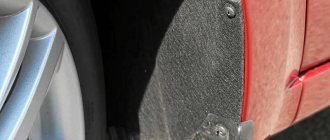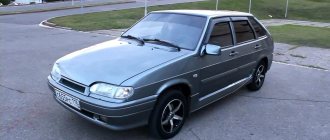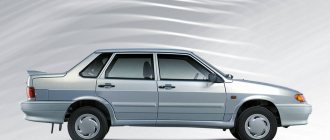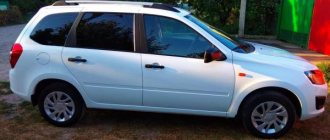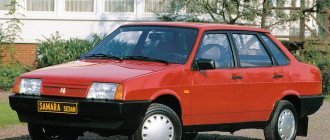Having become interested (the work involved spare parts), I tried to find out more about this “10th” hinge, but I never received a specific and complete answer anywhere. Some argue that the 10th has a greater turning angle, others claim that there is a groove somewhere. others have a longer threaded part. And in general, (judging by the catalogue, there is still a difference), is it possible to visually determine whether you have the “10th” in your hands, or the “8th”?
Answer 1. CV joints are not marked, but there are distinctive features. This is the length; on the left, the thrust collar of the cover is 2 mm on 2108, 10 mm on 2110.
It's more difficult on the right. There is no final option yet; there are temporary ones (it’s quite difficult to describe them), but the main feature is different lengths.
Ignatenko German Viktorovich
Chassis Design Department of JSC AVTOVAZ
Answer 2. For information, let me remind you that CV joint stands for constant velocity joint (popularly known as a grenade).
The problem of interchangeability of external CV joints has been solved; since 1999, unification has been carried out and all drives for cars 2108 and 2110 are equipped with external joints 2110-2215012. Hinges 2108-2215012 are not manufactured, and the design documentation has been cancelled. Comparing the two drawings, I did not find any external differences in the hinge bodies 2108-2215020-01 and 2110-2215020. The changes affected the internal dimensions and are aimed at increasing its resource. At the same time, the swing angle of the hinge also changed from 42 degrees (2108) to 44 degrees (2110). The maximum possible bending angle of the hinge for car 2110, with standard suspension, is 40 degrees.
Considering the above, if you still have 2108 CV joints in your stash, I think they can be used when repairing cars. 2110.
Source
A little history
The history of the model began in 1983. When designing it, the engineers took the VAZ 2108 as a basis. It was assumed that it would be a restyled version of the same eight, but in a sedan body, but the engineers overdid it and made too many changes that significantly increased the cost of the design. The project was liked by the management of AvtoVAZ, but due to the small budget they decided to postpone it. Instead, it was decided to minimize the costs of “transforming” the eight into a sedan. This is how the VAZ 21099 model was created.
VAZ-2110 Experienced (Series 0) 1985
The first batch of dozens was planned to be put into mass production in 1992, but due to the economic crisis, the idea was realized only three years later. The four-door VAZ 2110 sedan was produced at AvtoVAZ from 1995 to 2007. Over the years, engineers have created many modifications to the car. The most popular of them were the VAZ 2111 station wagon, the VAZ 2112 hatchback and the “Long version” of dozens of VAZ 21108 Premier.
VAZ-2110 Experienced (Series 300) 1990
Also, as experiments, a version of the car with a continuously variable VT1 variator from ZF, a two-door VAZ-21106 Coupe and a Lada 110 Consul were produced. The latest modification, by the way, was produced individually from 1997 to 2006 and was a limousine designed for 4 people. Inside the cabin there were retractable tables for passengers, a bar with a refrigerator and a mini-TV. Leather and wood were used for decoration.
VAZ-2110 Pre-production 1993–95
In 2009, the rights to produce the VAZ 2110 were acquired by the Ukrainian corporation Bogdan, which produced cars until 2014.
Specifications
Below are the technical characteristics of the VAZ 2110 and VAZ 21108 Premier.
| Options | 2110 | 21108 Premier |
| Length, mm | 4 265 | 4 440 |
| Width, mm | 1 680 | 1 676 |
| Height, mm | 1 420 | 1 424 |
| Ground clearance, mm | 170 | 170 |
| Front track, mm | 1 400 | 1 400 |
| Rear track, mm | 1 370 | 1 370 |
| Wheelbase, mm | 2 492 | 2 665 |
| Weight, kg | 1 060 | 1 100 |
The differences between these two modifications are in the length of the body: the Premier is 175 mm longer than the regular ten. At the same time, the increase in dimensions made it possible to expand the legroom for rear passengers and slightly increase the trunk. The engineers decided to disguise the expansion of the cabin not with a wide side pillar, but by lengthening the rear doors. Therefore, from the outside the car looks virtually unchanged.
Important points of the exterior
Unlike its predecessors, at the time of its release the VAZ 2110 acquired a modern look. The engineers abandoned the “chopped” parts and decided to decorate the body with attractive “inflated” parts. Thanks to the updated aerodynamic body kits, the car began to consume less fuel at high speeds than its predecessors.
Lada 110 (2110) 1995–2007
The engineering idea to introduce many additional parts and options into the car, which once made it too expensive, allowed AvtoVAZ to take a big technical step forward. Among the innovations are gas hood supports, air conditioning, and glued glass.
The new product from the Volzhsky plant nevertheless received criticism: the car enthusiast did not like the supposedly weighted feed. The “heaviness” is given to it by the rough rear wing and powerful bumper. But the car's optics are distinguished: in front there are large rectangular headlights, divided into two sections, in the rear there is a built-in wide panel that smoothly turns into taillights. Having examined the car in more detail, you understand: everything about it is simple. But the combination of these simple elements turned a car in the 90s into a work of art.
Lada 110 (2110) 1995–2007
The basic configuration of the new product was produced on 13-inch wheels, the “Norma” and “Lux” configurations included 14-inch “sneakers”, which, by the way, fit perfectly into the miniature dimensions of the car.
More than half of the bodywork of the dozen consists of galvanized steel, which was supposed to provide excellent anti-corrosion resistance. But this did not happen, and drivers, in order to protect the vehicle from rust, had to regularly treat the elements with anti-corrosion agent.
Lada 110-06 “Yellow Shark” (2110-06) 1996
It is also worth noting that the assembly of the Lada has always surprised its owners: the gaps between body elements in many places reached 7 millimeters. Because of such gaps, heat did not linger inside the cabin during the cold season. But the drivers joked that “good ventilation is achieved in the summer.” Laughter is laughter, but the problem of assembling domestic transport is relevant to this day.
Interior features
The interior space of the tenth family is no different in design features. Everything here is simple and accessible: a dashboard with a large speedometer, a four-spoke (in early models) or two-spoke (in later models) wheel. For the convenience of the driver, the center console is turned towards him, but because of this decision, the front passenger's left knee rests against it.
Torpedo Lada 110 (2110) 1995–2007
In the top ten, they abandoned the “stool seating”: now the driver could sit behind the wheel with his legs extended, and not with them bent, as was the case before. The dashboard itself was made of soft plastic, which did not creak in the cold and was pleasant to the touch.
The interior is cramped: while the front passenger can still put up with the inclined central panel, the rear passengers will have to be content with narrow legroom, a highly protruding tunnel in the floor and a low ceiling, the existence of which passengers learn about at the first speed bump.
Interior Lada 110 (2110) 1995–2007
The trunk easily fits four wheels or a large stroller. Its volume is 450 liters. However, it is not possible to increase the compartment due to the non-folding rear row of seats.
Model 2110 at the time of its release became the first model of the VAZ family to acquire an adjustable steering column.
Removing the front wheel drives of a VAZ-2110 car
We remove the drives to replace them or when dismantling the gearbox. Repair or replacement of the drive is required if there are knocking noises when cornering or increased vibration that occurs when the joints wear out. Wear of the hinges is caused by sand and dirt getting into the internal parts of the CV joint, when the rubber boots rupture.
We carry out the work on an inspection ditch or a lift.
To do this, remove the engine splash guard:
Using a 10mm socket, unscrew the five nuts for the front fastening of the mudguard to the body.
Use a 10mm wrench to unscrew the screws on the front plastic shield.
Using a 10mm wrench, unscrew the screws for the rear fastening of the plastic shield
Using a 10mm wrench, unscrew the two bolts securing the mudguard to the side members
To do this, drain the oil from the gearbox, use a 17 key to unscrew the plug and drain the oil into a container (volume - 4 l).
After draining the oil, screw the plug back in
We unscrew the front hub bearing nut, to do this we remove the hub cap
Use a narrow chisel to straighten the dented collar of the nut.
We lock the rear wheels with the handbrake, engage first gear and place shoes under the wheels.
Use a 30mm socket to loosen the hub bearing nut.
Loosen the wheel mounting bolts.
We hang up the front of the car and remove the wheel.
Unscrew the two ball joint mounting bolts
Engine modifications
The VAZ 2110 was produced only with gasoline carburetor and injection engines, which were combined with a 5-speed manual transmission. There were several of them, we will list just a few of them:
| Volume, l | Power, hp | Number of valves | Maximum power, km/h |
| 1,5 | 78 | 8 | 176 |
| 1,6 | 81 | 8 | 176 |
| 1,5 | 93 | 16 | 180 |
| 1,6 | 89 | 16 | 180 |
| 1,6 | 81 | 8 | 177 |
| 1,8 | 98 | 16 | 185 |
AvtoVAZ also produced experimental models: a sports ten with an Opel C20XE engine with a displacement of 2.0 liters and a ten with a rotary piston power plant. The latter, by the way, helped win many autocross competitions during the 90s. Cars with rotary engines did not make it into large-scale production, because It turned out that this modification has an extremely small resource for everyday use.
Options
The configurations of dozens today can be regarded as poor. Of course, at one time, even a minimal set of options was enough for comfortable movement, but now, with the development of technology, there are many more “wants”.
Lada 110 (2110) 1995–2007
The VAZ 2110 was equipped with electric windows, heated front seats, power steering and air conditioning. The Bogdans were equipped with electric power steering. Airbags and ABS were not provided.
In the “Norma” configuration, the VAZ 2110 interior was trimmed with velor fabric and supplemented with rear headrests. The more expensive “Lux” package differed from the others in the presence of an on-board computer and heated side mirrors.
